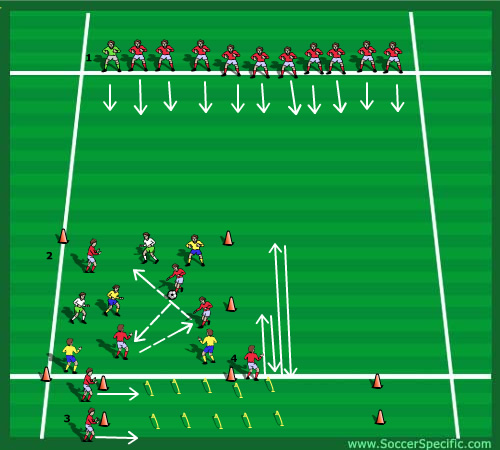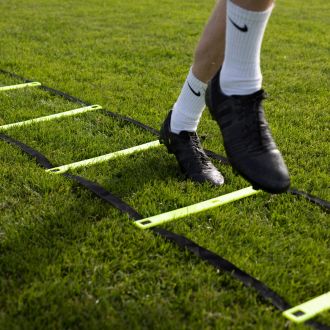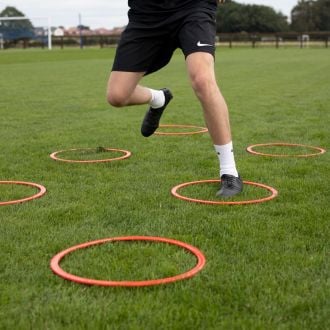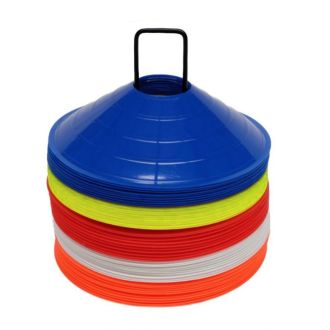Pre Match Warm Ups
Pre-Match Warm Up
Do you have a structure to your pre-match warm up? This essential preparation is often over looked – especially at grassroots. Managers end up completing match cards or stand about talking to parents leaving the players to their own device. It’s amazing how many players run out the changing room with a ball & what is the first thing they do? Have a shot at goal! Adapt your warm up to suit the age that you are working with & the conditions.
Here is my pre-match warm up.
Pre-Match Warm Up

Emphasis
Ideal warm up before matches.
I believe it is important for players to have a routine each week before matches. I think it is silly to try & introduce something new as players will be mentally focusing in for games & there is no point trying to get them to listen to new intructions.
The basics is to get them moving & start to get their body temperature up. Obviously adapt this to suit the climate & time of year. With younger players I like them all to have a ball but ensure they don’t start bad habits like shooting at goal straight away! They should dribble around a grid, performing skills & turns. I also let them have some time for keepie ups.
Once the body & muscles start to warm introduce some stretching & light ball work. I always like introducing a small sided possession game to start getting them up to match speed.
It is very important you don’t ignore your goalkeeper. At this point I let them break off from the group & have one of my assistants warm them up. If you don’t have the luxury of an assistant have one or two of your subs warm them up or the sub goalkeeper if you have one. Although it is important they know a routine so it doesn’t turn into ‘passie-shootie in’ (although most keepers will tell them what exactly they want to do.)
Make sure players stop in between for fluids. I then introduce some S.A.Q. sessions before developing into some explosive sprints.
It’s then important to let players have some free time to complete the warm up. Some may prefer to perform some more stretching while others may wish to shoot at goal or pass in groups of 2 or 3.
Set-Up
Start with all players lined up along the throw-in line.
Set up a 25 x 25 yard area. This is for the possession game & you can also use one of the lines for the explosive sprints.
Also organise the S.A.Q. area (as shown.)
Objectives
The coach (or possibly the captain) is at the front of the group & sets the rhythm & tempo of each exercise. The rest of the team is in line & starts along the throw-in line.
Start off at a slow jog pace, & then undertakes the following sequence;
- Jogs forwards to the opposite by-line of the pitch.
- Jogs backwards back.
- Shuffle side to side working on foot work going forward (2 to the left, 2 to the right.)
- Shuffle side to side working on foot work going backwards.
- Increase the pace, start skipping, & do the following exercises;
- Open extension stretch – Head up elbows slightly bent, push back, & then forwards to clap hands. X 10.
- Salute stretch – Head up elbows slightly bent, reach up, push back, & then come forwards to thigh level to clap hands. X 10.
- Parallel rotations – Head up, turn the head, & twist both arms to the rear (parallel to the ground) then return to the front. X 10 left & X 10 right.
- High knee lifts – Head up, bring the right knee up as close to the right shoulder (touch if possible), then return to the ground. X 10 left & X 10 right.
- Outside crescent kicks – Head up, high knee & subscribe an outside crescent kick (away from the centre line of the body) then return to the floor. X 10 left & X 10 right.
- Inside ankle touches – Head up bring your right foot up to touch your left hand & then return to the floor. X 10 left & X 10 right.
- Outside heel touches – Head up bring your right foot up to touch your right hand & then return to the floor. X 10 left & X 10 right.
- Rear heel touches – Head up bring your right foot up & touch your left hand behind you. X 10 left & X 10 right.
- On each of the exercises it is crucially important that each player works to their own limits. All of the exercises are done whilst moving across the pitch & back again, the coach or the captain setting the tempo, & rhythm at all times. After this phase is done then the players then work in groups of 2, for the rhythmic dynamic stretches.
This series of dynamic stretches are known as ‘pendulum stretches’. When working in pairs balance must be worked upon, as the one player swings to the front, the other swings to the back, in balance. This applies to the left & right also.
- Front & rear pendulum – With the players facing each other, left hand on each others shoulder for support, swing to the front & then to the rear, emphasise the height has to be equal. X 10 left & X 10 right.
- Left & right pendulum stretch – With the players facing each other, left hand to left hand for support, swing to the left & then to the right, emphasise the height has to be equal. X 10 left & X 10 right.
- Half pendulum stretch – With the players facing each other, hand to left hand for support, swing to the left & then as the leg swings to the right bend the knee up to the side. X 10 left & X 10 right.
Players now come into the grid to play keep ball. I generally overload the attack & play 8 v 4 (I select the back 4 to start & try & win the ball, then the midfield 4). Make sure you have a number of balls to feed in when a ball leaves the grid. Players should concentrate on their work rate on / off the ball & how they receive the ball. Encourage them to ‘keep the ball’ & play ‘easy pass’.
Break up the possession game with some static stretching.
After rotating players finish off the warm up with some S.A.Q. & sprints. I would have 3 reps for the S.A.Q.;
- 1 foot in between each cone.
- 2 feet in between each cone.
- Shuffle in between the cones.
After completing the S.A.Q., finish off with some explosive sprints, work in pairs using the outside of the grid (see diagram.);
- Both players facing to front, on coaches command, run 3/4 pace to first cone then sprint to last cone & then slowly jog back to the end of the line. Have players carry these exercises out at a steady place so you don’t have too long a line.
- Both players facing to front, on coaches command, jump up & shout their name (like they are going to head the ball), then sprint to last cone. Make sure players behind don’t stand too close, so they don’t land on their toes!
- Both players face each other & perform quick feet to first cone before turning & sprinting to last cone.
- Both players face each other & side shuffle to first cone before performing high fives, change lanes & sprint to last cone.
- Like before but instead of giving high fives they jump up & shoulder charge each other.
- Finally, players sprint forwards to first cone, then backwards to start, before sprinting to last cone.
Let players finish off the warm up with whatever they feel necessary. As each player has their own traditions, never interfere with this crucial period, as the players psychological well-being is at risk.
This is the last activity to be done before the players either return to the dressing room, or the match is about to start. I like to remind players the last important instructions & then they get into a huddle themselves. I like this as I feel it really helps to create a bond between the players.
Progressions
- Adjust the length of your warm up depending on weather conditions.
- Make sure you allow players time for them to complete their own warm up at the end.
Coaching
- It is your job to ensure that players are physically & mentally ready for kick off.



